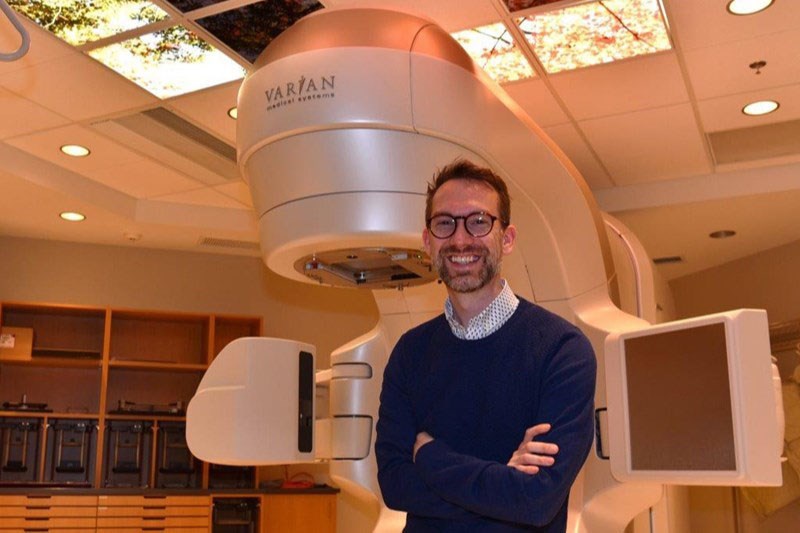Prince George radiation oncologist Robert Olson has built a career as a medical doctor finding ways for people to beat cancer and his latest work leading a provincial study using high-dose radiation treatments to shrink tumours has revealed encouraging results.
Olson’s innovative research at the BC Cancer Centre for the North in Prince George utilizing stereotactic ablative radiotherapy (SABR) to target cancer cells with high doses of precisely-focused radiation has been proven effective at controlling the spread of cancer while reducing the toxic side effects on patients revealed in earlier trials.
“This research is important as it showed that in a coordinated program with safety checks in place, the side effects from SABR are low, and the control of the cancer spread is high,” said Olson. “This trial also gave specific information on which body parts required more caution and study when treating, such as the liver and adrenal glands.”
The 381 patients at six B.C. cancer centres selected for the study from June 2016 through November 2020 had cancer which had spread from one location, such as the prostate gland or lung, to other sites.
The trial determined the incidence of grade 3-or-higher SABR toxic effects was less than five per cent, while the incidence of grade 2 effects was 18.6 per cent. That’s compared to a 29 per cent grade 2 rate and 4.5 per cent grade 3 toxicity in an earlier study.
Olson offered two explanations as to why there were fewer side effects.
Instead of having just one radiologist oncologist determine the radiation plan for each patient there were two, working from different centres, who worked together to calibrate the doses and target the tissue by making adjustments in fractions of millimetres. Those precise measurements minimized the healthy tissue affected by the treatment.
“We mandated that another centre, an oncologist and physicist, take a look at it and adjust it and make it an even better plan if they could,” said Olson. “It is computer-based, where you can open it up remotely from a different centre. Other provinces can't do this. They don’t have their centres connected.
“The other one is, when you’re planning radiation there’s always a trade-off between getting as high a dose as you can on the tumour and as low a dose as you can into the normal tissue that’s close by and we prioritize the normal tissue well above the target and really aggressively carve the dose away from things like the esophagus and spinal cord and brain and kidney.
The changes in treatment plans and the resulting decrease in the chance of side effects has stimulated the interest of the international researchers, Dr. Olson said. As research lead at BC Cancer – Prince George, the methodology Olson followed in the third phase of the SABR-5 trial minimizes the number of treatments required. The research team is investigating whether the treatment can improve survival rates and ultimately lead to a cure for some patients.
“An earlier, smaller phase II trial in 2019, called SABR-COMET, showed encouraging results with people living two times longer than those who did not receive the treatment,” said Olson. “However, there was three times the rate of side effects in those who received SABR, including a 30 per cent rate of mild side effects; approximately 15 per cent rate of serious side effects, for example, requiring hospitalizations; and a five per cent death rate from side effects. Therefore, we wanted to test if we could deliver SABR in a safer, yet equally effective manner with our SABR-5 trial.
“We specifically sought to determine if a large, coordinated provincial program, with several quality and safety mechanisms in place, could keep the side effect rate very low. We had also wanted to demonstrate that SABR can be safe, while still achieving high rates of tumour control, before we moved on to the larger SABR-COMET-3 randomized trial that we are currently running internationally from Prince George.”
Cancer recurrence does happen over time in areas treated with radiation but in Olson’s study the rates of recurrence were quite low. At one year, the control rate of tumours was 93 per cent, it was 90 per cent at two years and at three years it was 87 per cent controlled.
Olson said there are now four Prince George oncologists, five clinical staff and several radiology therapists involved in the SABR_COMET-3 follow-up study that began 18 months ago. It involves mostly Canadian cancer research teams with participation from researchers in the United Kingdom and Australia.
Based on their findings which showed acceptable rates of toxic effects, Olson and his team are planning to ramp up their clinical trial to involve more international researchers, which will require funding not sourced by standard government operating grants, and that will require extensive fundraising and community donations. The SABR-5 was being funded by the Canadian Institutes of Health Research, Varian Medical Systems and the BC Cancer Foundation.
Olson’s article was published Sept. 29 in the Journal of American Medical Association on Sept. 29.


